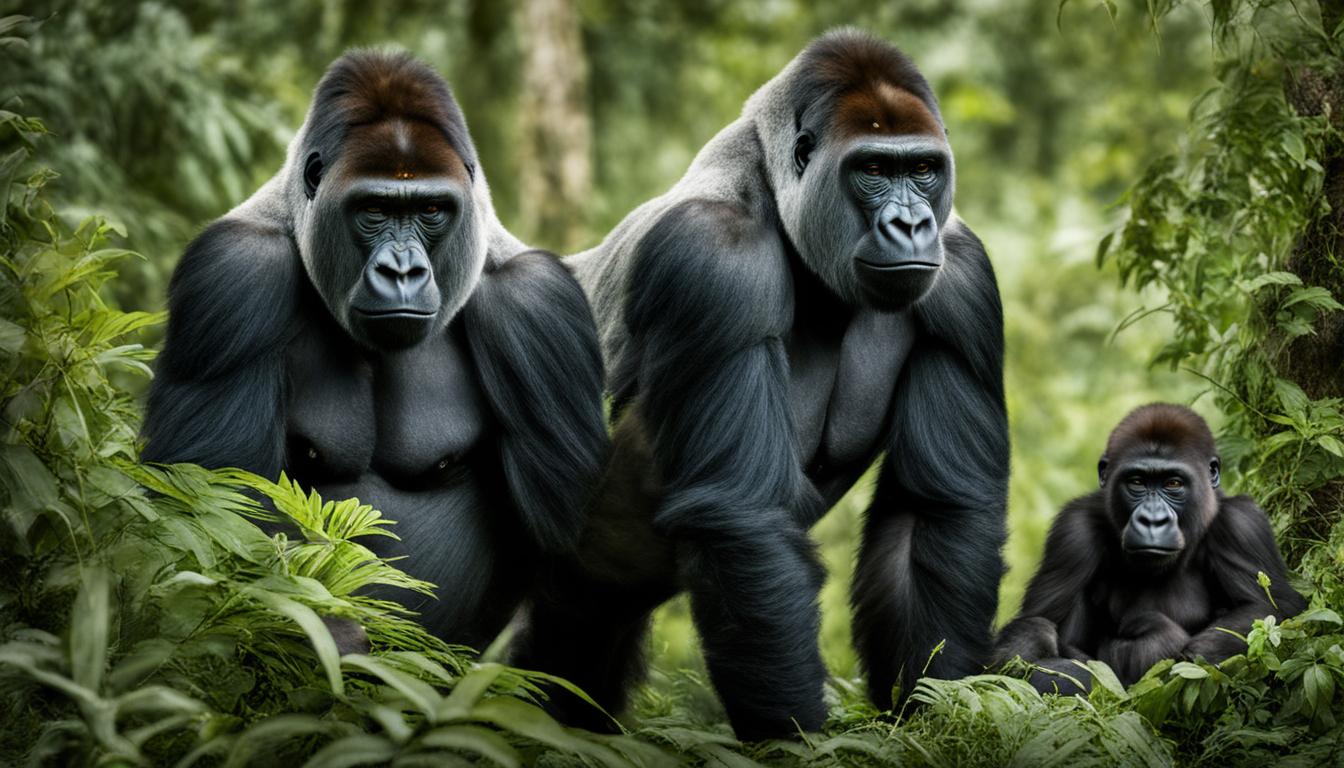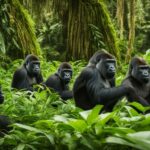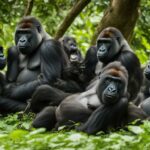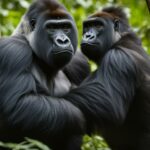In today’s world, where the survival of numerous species is at stake, gorilla conservation has emerged as a critical endeavor. The protection of gorillas is not only essential for their own existence but also for the preservation of their unique habitats and the diverse species that depend on them.
Gorillas have long been at the forefront of conservation efforts, with organizations like the WWF dedicating themselves to safeguarding these magnificent creatures. Through a range of conservation initiatives, they are working tirelessly to protect gorilla populations and their habitats.
Conservation efforts are focused on the improvement of protected areas, combating the illegal trade in gorilla products, and garnering support from local and international communities. By addressing these key aspects, organizations are striving to ensure a sustainable future for gorillas and their ecosystems.
Collaborative Conservation Projects for Different Gorilla Subspecies
The WWF actively collaborates with partners in gorilla range states to implement conservation projects specifically designed for each gorilla subspecies. These collaborative efforts aim to protect gorilla habitat, conserve gorilla populations, and improve the well-being of local communities. Let’s take a closer look at the projects dedicated to the Western lowland gorillas, Cross River gorillas, Eastern lowland gorillas, and Mountain gorillas.
Collaborative Conservation Projects for Western Lowland Gorillas
The WWF, in collaboration with local partners, focuses on protecting the Western lowland gorillas in their range countries, such as Cameroon, Republic of Congo, and Equatorial Guinea. These projects involve strengthening protected areas, implementing anti-poaching measures, and working with local communities to promote sustainable livelihoods that reduce their reliance on gorilla habitats.
Collaborative Conservation Projects for Cross River Gorillas
The Cross River gorillas, one of the most critically endangered gorilla subspecies, are found in fragmented populations along the Nigeria-Cameroon border. The WWF partners with government agencies, local communities, and other conservation organizations to protect their remaining habitat and promote sustainable development in the region. These projects involve community-based patrols, habitat restoration, and awareness campaigns to reduce illegal hunting and habitat destruction.
Collaborative Conservation Projects for Eastern Lowland Gorillas
The Eastern lowland gorillas, also known as Grauer’s gorillas, are found in the Democratic Republic of Congo’s (DRC) dense forests. The WWF works closely with local communities, park authorities, and other stakeholders to combat illegal mining, improve law enforcement, and address the root causes of deforestation. These projects aim to protect the gorillas and their habitat while also benefiting the local communities through sustainable livelihood initiatives.
Collaborative Conservation Projects for Mountain Gorillas
The Mountain gorillas, found in the Virunga Massif and Bwindi Impenetrable National Park, are the most well-known and closely monitored gorilla subspecies. The WWF collaborates with national park authorities, local communities, and other organizations to protect their habitat, reduce poaching, and improve the livelihoods of people living near gorilla habitats. These conservation projects have been successful in increasing the population of Mountain gorillas, showcasing the positive impact of collaborative efforts.
Policy Initiatives for Gorilla Conservation
Gorilla conservation efforts rely heavily on policy initiatives that aim to combat the various threats faced by these magnificent creatures in the wild. One crucial policy instrument in place is the Gorilla Agreement, which is part of the Convention on Migratory Species. This legally binding agreement obliges governments in the ten countries where gorillas reside to collaborate in protecting these endangered species.
The Gorilla Agreement focuses on critical aspects such as anti-poaching and law enforcement. By working together, governments can develop coordinated solutions to address these threats and ensure the long-term survival of gorillas. The implementation of this agreement has been actively supported by organizations like the WWF and TRAFFIC, who have played a vital role in negotiating and advocating for its adoption.
Effective anti-poaching measures are vital for gorilla conservation. By enforcing stringent laws and regulations, governments can deter poachers and reduce the illegal trade in gorilla products. Collaboration between law enforcement agencies and conservation organizations is essential to ensure efficient monitoring and enforcement, ultimately protecting gorillas from harm.
| Policy Initiatives | Description |
|---|---|
| Gorilla Agreement | A legally binding agreement that obliges governments to collaborate on gorilla protection |
| Anti-poaching | Enforcing laws and regulations to deter poachers and reduce the illegal trade in gorilla products |
| Law enforcement collaboration | Working together between law enforcement agencies and conservation organizations to monitor and enforce regulations |
Direct Protection and Monitoring of Gorilla Populations
Sustained protection of wild gorilla populations is crucial for their survival. Organizations like the Fossey Fund are dedicated to the daily protection and monitoring of gorillas, employing strategies that have been instrumental in saving the critically endangered mountain gorillas from extinction. These same methods are now being extended to protect the endangered Grauer’s gorillas, ensuring their long-term viability.
The Fossey Fund and other conservation groups maintain a direct presence in gorilla habitats, allowing for data collection on gorilla behaviors, population dynamics, and other important information. Highly trained monitoring teams track gorilla groups, record their location, monitor individual health and group composition, and collect detailed behavioral data. These efforts provide valuable insights into the social structures, breeding patterns, and health of gorilla populations, helping inform conservation strategies and initiatives.
| Key Data Collected during Direct Monitoring | Significance |
|---|---|
| Gorilla group composition | Understanding the social dynamics and family structures of gorillas |
| Individual health monitoring | Identifying and addressing health concerns and disease outbreaks |
| Population size and distribution | Assessing the overall health and growth of gorilla populations |
| Behavioral data | Studying feeding habits, reproduction, and interaction with their environment |
The data collected through direct protection and monitoring efforts play a critical role in the conservation of gorillas. It allows conservation organizations and researchers to assess the effectiveness of conservation strategies, adapt interventions as needed, and monitor the overall health and well-being of gorilla populations. With this comprehensive understanding, conservationists can develop targeted approaches that address the unique challenges facing different gorilla subspecies, ensuring their long-term survival.
Combating Threats to Gorillas
Gorillas, like many endangered species, face numerous threats that pose a significant risk to their survival. These threats include habitat loss due to deforestation, diseases, and poaching. In order to protect these magnificent creatures, various efforts and strategies are being implemented.
Habitat loss, caused by deforestation and the expansion of agriculture, is a major threat to gorillas. The destruction of their natural habitats not only displaces gorillas but also disrupts the delicate balance of the ecosystems they depend on. Conservation organizations are actively working to combat habitat loss by advocating for sustainable land use practices and supporting initiatives that promote reforestation and habitat restoration.
“Habitat loss is one of the most significant threats facing gorillas today. Our goal is to protect and restore their natural habitats, ensuring the long-term survival of these incredible creatures,” says Dr. Jane Smith, a leading primatologist and conservationist.
Diseases, such as Ebola and respiratory infections, also pose a grave threat to gorillas. As highly susceptible to human diseases, gorillas can easily contract and spread illnesses. Efforts are underway to educate local communities about the importance of hygiene practices and vaccinations to prevent the transmission of diseases to gorillas and other wildlife.
Poaching remains one of the greatest threats to gorilla populations. The illegal trade in gorilla products, such as bushmeat and trophies, continues to drive the decline of these endangered animals. Collaborative efforts between conservation organizations, local communities, and law enforcement agencies are essential in combating poaching. Increased protection through the deployment of more forest rangers, the establishment of protected areas, and the enforcement of wildlife laws are crucial in curbing illegal hunting and ensuring the safety of gorillas.
| Threats | Impact | Conservation Efforts |
|---|---|---|
| Habitat Loss | Displacement of gorillas and disruption of ecosystems | – Advocacy for sustainable land use practices – Support for reforestation and habitat restoration initiatives |
| Diseases | High susceptibility and transmission of illnesses | – Education on hygiene practices – Vaccination programs |
| Poaching | Illegal trade and decline in population | – Collaboration with communities and law enforcement agencies – Increased protection and enforcement of wildlife laws |
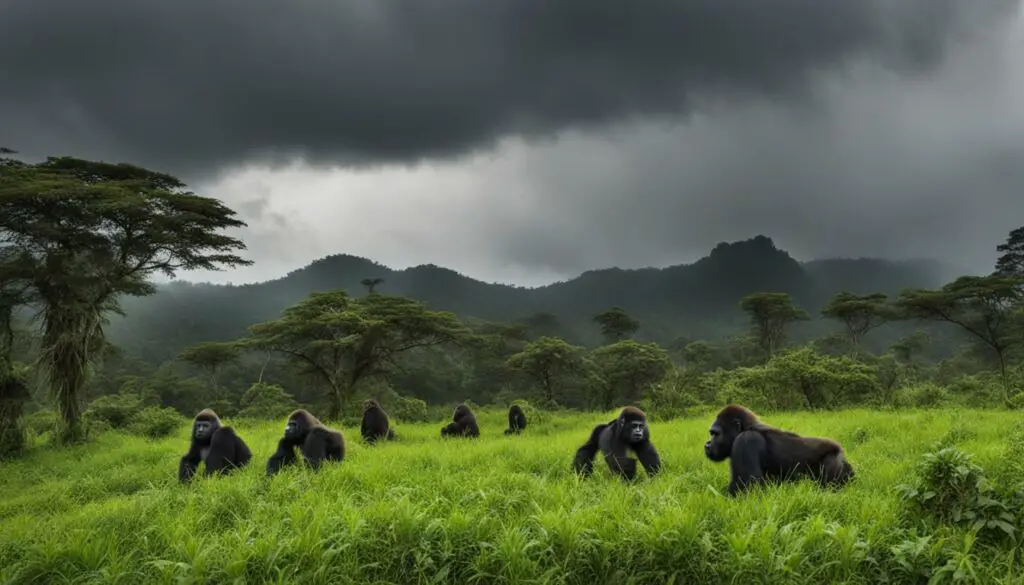
Education for Conservation
Education plays a crucial role in gorilla conservation efforts. By raising awareness about the importance of protecting gorillas and their habitats, communities can become active participants in conservation initiatives. Outreach programs conducted by conservation organizations aim to educate local communities about the ecological and economic benefits of gorilla conservation. These programs also emphasize the connection between human health and the well-being of gorillas, promoting hygiene practices to prevent disease transmission.
Eco-Tourism for Conservation
Eco-tourism, when properly managed, can provide funding for conservation initiatives and support local economies. By offering sustainable alternatives to activities that harm gorilla habitats, such as logging or poaching, eco-tourism creates incentives for communities to protect gorillas and their natural environments. However, it is crucial to ensure that eco-tourism activities are well-regulated and minimize disturbance to gorilla populations, as increased human presence can introduce stress and disease risks.
Combatting threats to gorillas requires a comprehensive and collaborative approach. Through habitat protection, disease prevention, anti-poaching measures, education, and sustainable tourism practices, we can work towards securing a brighter future for these incredible creatures and the ecosystems they call home.
Endangered Species International’s gorilla conservation project
Endangered Species International is actively involved in protecting endangered gorillas and their habitats in the Republic of Congo. This comprehensive project focuses on various aspects of gorilla conservation, including population surveys, anti-poaching efforts, protected area establishment, and community engagement.
Gorilla Population Surveys
Endangered Species International conducts regular surveys to gather data on gorilla populations in the Republic of Congo. These surveys help monitor population trends, identify critical habitats, and assess the success of conservation efforts. By understanding the distribution and size of gorilla populations, the organization can implement targeted conservation strategies to protect these magnificent creatures.
Anti-Poaching Efforts
To combat the threat of poaching, Endangered Species International recruits and trains former wildlife hunters as patrol guards and field assistants. These individuals use their knowledge of the forest and wildlife to actively protect gorillas and their habitats. Anti-poaching patrols are conducted regularly, aiming to deter illegal activities and ensure the safety of gorilla populations.
Protected Area Establishment
Creating protected areas is crucial for safeguarding gorilla habitats. Endangered Species International works with local communities and government authorities to establish protected areas that provide a safe haven for gorillas. These protected areas help maintain suitable habitat conditions, reduce human-wildlife conflict, and preserve the biodiversity of the region.
Community Engagement and Sustainable Livelihoods
Endangered Species International recognizes the importance of engaging local communities in gorilla conservation efforts. The organization conducts educational activities in schools to raise awareness about the importance of wildlife protection and the benefits of gorilla conservation. Additionally, the project focuses on fostering sustainable livelihood alternatives for local communities, providing them with opportunities to generate income while minimizing their reliance on activities that harm gorilla populations and their habitats.
| Conservation Activities | Impact |
|---|---|
| Gorilla population surveys | Provides crucial data for targeted conservation strategies |
| Anti-poaching efforts | Reduces threats to gorilla populations and deters illegal activities |
| Protected area establishment | Safeguards gorilla habitats and biodiversity |
| Community engagement and sustainable livelihoods | Educates communities and provides alternative sources of income |
Conclusion
Gorilla conservation is a vital endeavor that requires a multi-faceted approach. Efforts to protect gorillas and their habitats are crucial to ensure their survival and contribute to the preservation of diverse ecosystems. Organizations like the WWF and Endangered Species International are making significant strides in gorilla conservation through collaborative projects, direct protection, and education.
However, the work is far from over. Ongoing support and continued efforts are essential to secure a sustainable future for these endangered and critically endangered species. By joining the cause and contributing to gorilla conservation, you can play a part in protecting our primate cousins, saving gorillas from extinction, and fostering a healthier planet.
Together, we can safeguard the legacy of gorillas for future generations, creating a world where these magnificent creatures thrive and their habitats are protected. The time to act is now. Join the efforts to conserve gorillas, protect their habitats, and secure a sustainable future for these incredible creatures.
How Can Conservation Efforts Impact the Current Status of Gorilla Populations?
Conservation status of gorillas is often impacted by human activities such as poaching and habitat destruction. Efforts to protect and conserve gorilla populations through initiatives like anti-poaching patrols and reforestation can greatly improve their current status. Establishing protected areas and promoting ecotourism also play a significant role in conservation efforts.
FAQ
What are the key conservation efforts to protect gorillas?
The key conservation efforts to protect gorillas include improving the effectiveness of protected areas, halting the illegal trade in gorilla products, and increasing support for gorilla conservation among local and international communities. Additionally, collaboration with partners in gorilla range states, habitat protection, anti-poaching measures, community engagement, and policy initiatives are all crucial in ensuring the protection of gorillas and their habitats.
What collaborative conservation projects are dedicated to different gorilla subspecies?
There are specific projects dedicated to each gorilla subspecies. These projects focus on Western lowland gorillas, Cross River gorillas, Eastern lowland gorillas, and Mountain gorillas. The aim of these projects is to conserve gorilla habitat and populations while also improving the well-being of local communities.
What is the Gorilla Agreement and what does it entail?
The Gorilla Agreement is part of the Convention on Migratory Species and legally obliges governments in the 10 countries where gorillas live to cooperate in combatting threats faced by gorillas in the wild. This includes issues such as anti-poaching and law enforcement. The agreement is legally binding and requires collaboration between governments to find coordinated solutions for gorilla conservation.
How are gorilla populations directly protected and monitored?
Gorilla populations are directly protected and monitored through daily presence in the forests. Monitoring teams track gorilla groups, record their location, monitor individual health and group composition, and collect detailed behavioral data. This data helps in understanding gorilla behaviors, population dynamics, and other important information necessary for their conservation.
What are the main threats to gorillas and how are they combated?
The main threats to gorillas include habitat loss, disease, and poaching. Conservation organizations run outreach programs to educate communities about the importance of gorilla conservation and promote hygiene practices to prevent the spread of diseases. Increased protection through the deployment of more forest rangers, the establishment of protected areas, and better monitoring of gorilla populations are crucial to prevent further hunting and disease-related deaths. Eco-tourism can provide funding for conservation initiatives and alternative sources of income for local communities, but it must be carefully managed to minimize disturbance and disease transmission.
What does Endangered Species International’s gorilla conservation project entail?
Endangered Species International has a comprehensive project in the Republic of Congo aimed at protecting endangered gorillas and their habitats. This project involves conducting surveys of gorilla populations, recruiting and training former wildlife hunters as patrol guards and field assistants, conducting anti-poaching patrols, creating protected areas, and carrying out educational activities in schools. The project also focuses on fostering sustainable livelihood alternatives for local communities and raising awareness of wildlife laws and penalties for violations.
How can I contribute to gorilla conservation?
You can contribute to gorilla conservation by supporting organizations like the WWF and Endangered Species International through donations or volunteering. Additionally, you can raise awareness about the importance of gorilla conservation among your friends, family, and community. By joining the cause, you can help protect our primate cousins from extinction and contribute to the preservation of the diverse ecosystems they inhabit.

